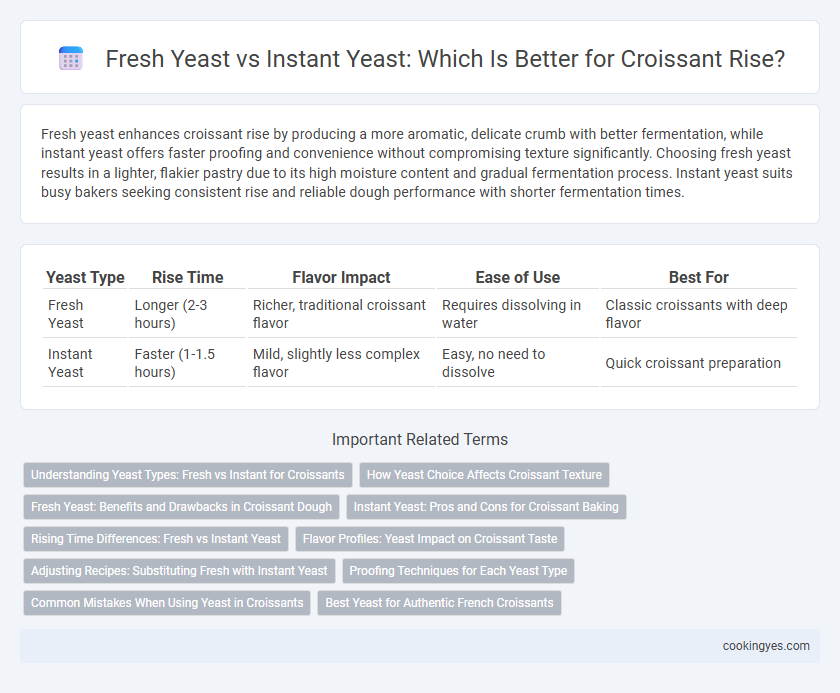Fresh yeast enhances croissant rise by producing a more aromatic, delicate crumb with better fermentation, while instant yeast offers faster proofing and convenience without compromising texture significantly. Choosing fresh yeast results in a lighter, flakier pastry due to its high moisture content and gradual fermentation process. Instant yeast suits busy bakers seeking consistent rise and reliable dough performance with shorter fermentation times.
Table of Comparison
| Yeast Type | Rise Time | Flavor Impact | Ease of Use | Best For |
|---|---|---|---|---|
| Fresh Yeast | Longer (2-3 hours) | Richer, traditional croissant flavor | Requires dissolving in water | Classic croissants with deep flavor |
| Instant Yeast | Faster (1-1.5 hours) | Mild, slightly less complex flavor | Easy, no need to dissolve | Quick croissant preparation |
Understanding Yeast Types: Fresh vs Instant for Croissants
Fresh yeast provides a delicate aroma and smooth texture ideal for croissant dough, promoting a slow, controlled rise that enhances flavor complexity. Instant yeast, with its higher concentration and rapid activation, shortens proofing time but may result in a less nuanced taste and slightly different crumb structure. Bakers prioritize fresh yeast for traditional, flaky layers while using instant yeast for efficiency and consistent rise in commercial production.
How Yeast Choice Affects Croissant Texture
Fresh yeast enhances croissant texture by producing a more delicate and airy crumb due to its higher moisture content and slow fermentation process. Instant yeast yields a quicker rise but can result in a denser, less flaky pastry as it generates more carbon dioxide in a shorter time. Choosing fresh yeast is ideal for achieving the classic light, buttery layers characteristic of traditional croissants.
Fresh Yeast: Benefits and Drawbacks in Croissant Dough
Fresh yeast provides a superior rise in croissant dough due to its high moisture content and active fermentation, resulting in a more complex flavor and flakier texture. It requires careful handling and refrigeration, as it has a shorter shelf life and can spoil quickly compared to instant yeast. Bakers favor fresh yeast for traditional croissants to achieve a tender crumb and distinct buttery aroma, despite the need for precise temperature control during proofing.
Instant Yeast: Pros and Cons for Croissant Baking
Instant yeast offers faster fermentation and easier handling compared to fresh yeast, making it ideal for croissant dough that requires precise layering and timing. It provides consistent rise and longer shelf life but may lack some of the nuanced flavors produced by fresh yeast during slow fermentation. Bakers often choose instant yeast for its convenience and reliability despite a slight trade-off in the traditional buttery flavor profile of croissants.
Rising Time Differences: Fresh vs Instant Yeast
Fresh yeast typically requires a longer rising time for croissant dough, often extending to 1.5 to 2 hours, which allows a more gradual fermentation process that enhances flavor complexity. Instant yeast accelerates the rise, reducing it to about 1 hour, making it suitable for faster preparation but may slightly compromise the depth of taste. Choosing between fresh and instant yeast impacts the balance between rising time efficiency and the rich, buttery texture crucial for an ideal croissant.
Flavor Profiles: Yeast Impact on Croissant Taste
Fresh yeast produces a richer and more complex flavor in croissants due to its higher moisture content and active fermentation process, which allows for longer proofing times and enhanced aromatic compounds. Instant yeast offers a more consistent rise with faster fermentation but results in a milder and less nuanced flavor profile. Bakers seeking a traditional buttery and slightly tangy taste typically prefer fresh yeast for its superior impact on croissant flavor.
Adjusting Recipes: Substituting Fresh with Instant Yeast
Substituting fresh yeast with instant yeast for croissant dough requires reducing the quantity to about 40-50% of the fresh yeast amount due to instant yeast's higher potency and faster fermentation. Adjusting proofing times is crucial since instant yeast accelerates dough rise, often allowing a shorter proofing period that enhances lamination and flakiness. Maintaining dough temperature around 24degC supports optimal yeast activity and ensures consistent rise and texture in croissants.
Proofing Techniques for Each Yeast Type
Fresh yeast requires a longer, slower proofing process at a consistent temperature of 75degF to develop the buttery, flaky layers characteristic of croissants. Instant yeast, by contrast, allows for a faster rise and can be proofed at slightly higher temperatures (around 80degF) without compromising dough structure. Proper proofing techniques for fresh yeast include covering dough to retain moisture, while instant yeast benefits from a well-balanced environment to optimize carbon dioxide production for maximum rise.
Common Mistakes When Using Yeast in Croissants
Using fresh yeast instead of instant yeast in croissant dough can cause inconsistent rising times due to differences in moisture content and activation speed, leading to uneven layers. Common mistakes include not proofing fresh yeast properly and adding instant yeast directly to cold ingredients, which slows fermentation and reduces dough elasticity. Maintaining precise fermentation temperatures and timing is crucial to avoid over-proofing or under-proofing, both of which compromise the croissant's flaky texture and volume.
Best Yeast for Authentic French Croissants
Fresh yeast, known for its strong fermentation power and subtle aroma, is traditionally preferred for authentic French croissants, providing a delicate crumb and rich flavor. Instant yeast offers convenience and a faster rise but may lack the depth of taste and texture that fresh yeast imparts in laminated dough. Bakers aiming for genuine French croissant quality typically choose fresh yeast to achieve the signature flaky layers and buttery softness.
Fresh yeast vs instant yeast for croissant rise Infographic

 cookingyes.com
cookingyes.com